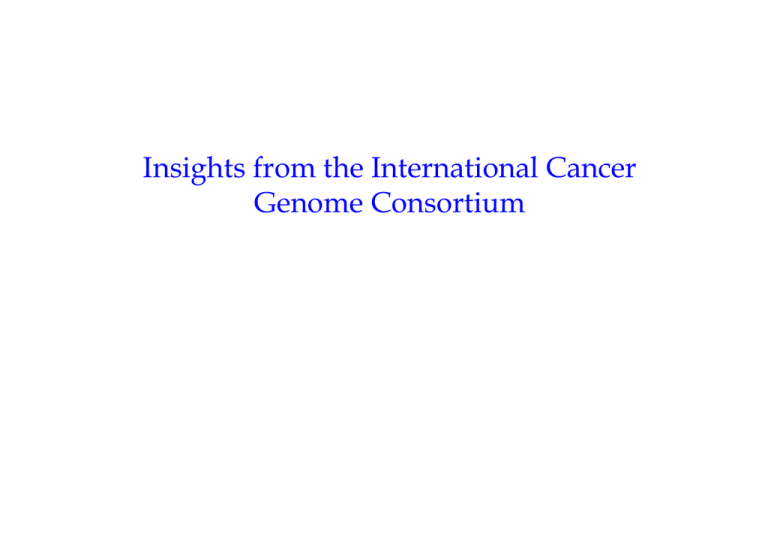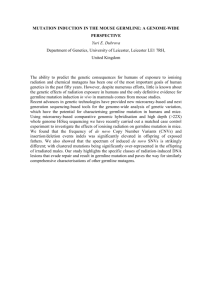Insights from the International Cancer Genome Consortium
advertisement

Insights from the International Cancer Genome Consortium Mapping all somatic mutations in cancer Mapping all somatic mutations in cancer IntegratedGenomicAnalysesofOvarianCarcinoma TheCancerGenomeAtlasResearchNetwork Nature 2011 (in press) High frequency novel mutations in granulosa and clear cell ovarian cancers Shah et al (2009) Wiegand et al (2010) 95% FOXL2 49% ARID1a Mountains and hills in colorectal cancer Wood et al (2007) Science •Commonly mutated genes already found (mountains) •Newly identified genes are at a low frequency (hills) When a low frequency mutation is found - is it a passenger or a driver of cancer? Evidence of a driver Mutation occurs at a higher frequency than expected by chance – size of gene, proximity to fragile sites Mutation found in independent datasets Mutation is biologically plausible – non-synonymous, pathogenic Functional studies demonstrate an effect in cells/animals Common versus rare cancers Rare cancers – often have single (or a few) dominant drivers Common solid cancers – some common mutations but also many low frequency mutations Few pathways to transformation Multiple pathways to transformation Single oncogene addicted therapeutic targets eg. Kit in gastrointestinal stromal tumours Many potential targets but at a low frequency – few new Her2’s Extensive repertoire for development of resistance Novel insights into cancer biology by resequencing Structural change (Pleasance Nature 2010) Patterns of metastatic spread (Campbell et al Nature 2010) Chromothripsis (Stephens et al Cell 2011) Inherited mutations Classical linkage studies High penetrance, uncommon Genome wide association study (GWAS) Common and low risk Inherited mutations Classical linkage studies High penetrance, uncommon Genome wide association study (GWAS) Common and low risk Tumour genome studies Resequencing of low risk loci in cancer patients Novel germline mutations eg. PALB2 Moderate-high penetrance rare variants BRCA1 and BRCA2 germline mutations in ovarian cancer Risk of ovarian cancer in germline carriers 30-80% 5-18% frequency of germline mutations in ovarian cancer Risk of carrying a germline allele if a women presents with ovarian cancer unclear. Why is this important? • Identification of at risk family members • Germline status influences response to conventional and targeted therapy – PARP inhibitors Provision of genetic testing is based on family history and age of onset AOCS 1000 women study Gillian Mitchell (co-PI) Stephen Fox Cliff Meldrum Anna deFazio Sian Fereday Michael Friedlander Penny Webb Kathryn Alsop Mary-Anne Young AOCS study design Include: Primary ovary, peritoneal, fallopian tube: Blood available Serous, undifferentiated, clear cell, high grade endometrioid Testing: All exons, splice sites Sanger sequencing and MLPA (large deletions) NATA accredited testing lab (Peter Mac Pathology) High frequency germline BRCA mutations in serous ovarian cancer • 16% of serous cancers were positive for a germline BRCA1 or BRCA2 mutation • 43% of mutation positive women did not have a family history suggestive of a carrier • Doubt that ‘clear cell’ and ‘endometrioid’ BRCA cases were as initial histological diagnosis • Current genetic testing guidelines should change to offer BRCA testing to all women with invasive ovarian cancer High response rates to second line platinum in carriers – even those with short first line response First Line PLATINUM Mutation + Second Line PLATINUM RECIST 11% Resistant <6 months 15% RECIST+ 89% >6 months 85% Responsive The ‘Standard Model’ of molecularly targeted therapy Find the genes driving growth Figure out the biology of the cancer Make a specific drug Treat only those patients with the specific event Molecularly targeted therapy in GIST and NSCLC Gastrointestinal stromal tumour Imatinib Patients alive Years Historicalaveragesurvival Lynch et al (2004) The ‘Standard Model’ of molecularly targeted therapy A mutation must be present in a reasonable fraction of cases The corresponding protein must be drugable The tumour must have a substantial dependency on the target that is not easily reverted Adaptation by cancer genome in the face of monotherapy Nature Reviews Cancer 2007 Alternative pro-angiogenic factors BMDC recruitment Increased pericyte coverage Increased invasion Increased time to relapse through inhibition of angiogenesis in ovarian cancer Median increased time to relapse 4.7months N=1873 Median increased time to relapse 1.7months N=1528 Adaptation by cancer genome in the face of monotherapy Nature 2008 A shift in our approach to therapy? Molecular nostic diagnostic Transient responses? M Monotherapy Make a drug g Cancer Identify key components Integrate information to comprehensively ‘explain’ individual cancers in real-time Understand adaptive processes that allow resistance t Combination and adaptive therapy Durable response?






